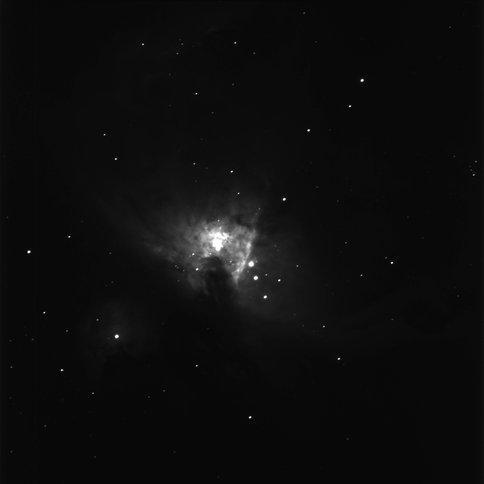2009 Annual Science Report
 University of Hawaii, Manoa
Reporting | JUL 2008 – AUG 2009
University of Hawaii, Manoa
Reporting | JUL 2008 – AUG 2009
VYSOS Construction
Project Summary
The VYSOS project aims at surveying all the major star forming regions
all across the entire northern and southern sky for variable young
stars. Two small survey telescopes have been purchased and provide
large area shallow observations, and two larger telescopes allow
deeper more detailed observations. All observations are done
robotically.
Project Progress
As in previous years, my major effort during the past year continues to be the preparation of the VYSOS project. VYSOS (Variable Young Stellar Objects Survey) consists of a 20 inch telescopes, mounted in Hawaii at Mauna Loa and a 16 inch telescope already mounted in Chile at Cerro Armazones. The northern telescope is owned and operated by me, and the southern telescope is owned and operated by Rolf Chini, a colleague at the Ruhr-Universitat Bochum in Germany.
The goal of our project is to have these two fully robotic telescopes monitor all star forming regions along the entire Galactic plane within about 2 kpc in order to understand the photometric variability of solar-like young stars. Such variability can have a number of causes, mainly accretion activity, starspots, eclipses by companions or dustclouds, and magnetic reconnection events. Almost nothing is known about the timescales and amplitudes of these phenomena, and the VYSOS project will put this on a firm footing by monitoring many tens of thousands of young low-mass stars over the next decade or more.
To survey larger swaths of the sky, we have installed a 135 mm apochromatic refractor at the Mauna Loa Observatory. It has a 2.9 × 2.9 degree field and can reach 17th magnitude in 5 min exposures. We are currently performing surveys of large areas of the Milky Way with this telescope, together with a similar survey done by a 150 mm refractor installed at our site in Chile. These small but highly efficient telescopes will also be used for monitoring bright comets as they enter the inner Solar System. Our northern refractor alone has already obtained over 30,000 images in the past 16 months.
Our UHNAI postdoc Martin Paegert from Germany, who after two years finished his postdoc in September 2009, has been focusing on the detection of extrasolar planets through transits observed with the VYSOS telescopes. He has been in charge of developing the extraction techniques needed to find the transiting planets among millions of light curves, and all the control software necessary for the operation of our telescopes.
During the past year we have also developed an all-sky camera that allows us to monitor the observing conditions via the internet.

The VYSOS telescope will be surveying young star forming regions. The telescope had its first light in early March 2009. The facility will enable exciting new research projects in the study of circumstellar disks and how they accrete onto their young stars.
First light image of a star-forming region taken with the VYSOS facility on Mauna Loa.
Publications
-
Aspin, C., & Reipurth, B. (2009). V1647 ORIONIS: OPTICAL PHOTOMETRIC AND SPECTROSCOPIC MONITORING THROUGH THE 2003-2006 OUTBURST. The Astronomical Journal, 138(4), 1137–1158. doi:10.1088/0004-6256/138/4/1137
-
Aspin, C., Greene, T. P., & Reipurth, B. (2009). V1647 ORIONIS: KECK/NIRSPEC 2 μm ECHELLE OBSERVATIONS. The Astronomical Journal, 137(2), 2968–2980. doi:10.1088/0004-6256/137/2/2968
-
Aspin, C., Reipurth, B., Beck, T. L., Aldering, G., Doering, R. L., Hammel, H. B., … Vivian, U. (2009). V1647 ORIONIS: REINVIGORATED ACCRETION AND THE RE-APPEARANCE OF MCNEIL’S NEBULA. The Astrophysical Journal, 692(2), L67–L71. doi:10.1088/0004-637x/692/2/l67
-
Bally, J., Walawender, J., Reipurth, B., & Thomas Megeath, S. (2009). OUTFLOWS AND YOUNG STARS IN ORION’S LARGE COMETARY CLOUDS L1622 AND L1634. The Astronomical Journal, 137(4), 3843–3858. doi:10.1088/0004-6256/137/4/3843
-
Connelley, M. S., Reipurth, B., & Tokunaga, A. T. (2009). AN ADAPTIVE OPTICS SURVEY FOR CLOSE PROTOSTELLAR BINARIES. The Astronomical Journal, 138(5), 1193–1202. doi:10.1088/0004-6256/138/5/1193
-
Haikala, L. K., & Reipurth, B. (2010). Near infrared imaging of the cometary globule CG 12. A&A, 510, A1. doi:10.1051/0004-6361/200913084
-
Lee, C-F., Mao, Y-Y., & Reipurth, B. (2009). INFALL AND ROTATION MOTIONS IN THE HH 111 PROTOSTELLAR SYSTEM: A FLATTENED ENVELOPE IN TRANSITION TO A DISK?. The Astrophysical Journal, 694(2), 1395–1401. doi:10.1088/0004-637x/694/2/1395
-
Rodríguez, L. F., Torrelles, J. M., Anglada, G., & Reipurth, B. (2008). HIGH-ANGULAR-RESOLUTION OBSERVATIONS AT 7 MM OF THE CORE OF THE QUADRUPOLAR HH 111/121 OUTFLOW. The Astronomical Journal, 136(5), 1852–1856. doi:10.1088/0004-6256/136/5/1852
- Kajdic, P., Reipurth, B., Raga, A.C. & Walawender, J. (2010, In Press). Herbig-Haro Objects around CG~30. Rev. Mex. Astron. Astrophys.
-
PROJECT INVESTIGATORS:
-
PROJECT MEMBERS:
Martin Paegert
Postdoc
Josh Walawender
Postdoc
-
RELATED OBJECTIVES:
Objective 1.1
Formation and evolution of habitable planets.
Objective 1.2
Indirect and direct astronomical observations of extrasolar habitable planets.
Objective 2.2
Outer Solar System exploration

